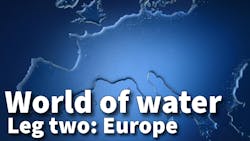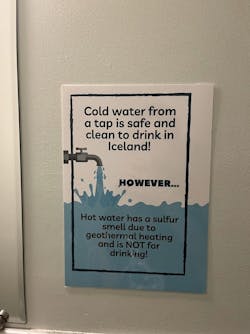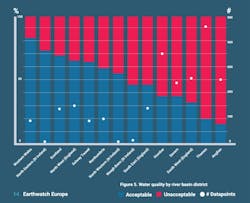World of water leg two: Approaching drinking water from all angles in Europe
When I set out on my year-long research fellowship, my goal was to compare and contrast global experiences with drinking water on six continents. After my first travel leg in Latin America, I wrote about the meetings I had with NGOs, companies, researchers and agencies working to expand access to clean and safe drinking water in the midst of heightened insecurity. From there, my focus shifted to Europe, where many global water organizations are headquartered–from UN Water in Geneva to the World Water Council in Marseille–and I was excited to connect with changemakers, advocates, and innovators across the 12 countries that I visited. I arrived in late November in the United Kingdom, and made my way to Spain, Belgium, Germany, Poland, Austria, Slovakia, Romania, Denmark, Finland, Norway and Iceland. All but one of the top 20 of Yale’s Environmental Performance Index for “Sanitation and Drinking Water” are in Europe, nine of which I visited. Japan is the only non-European country ranked. Baseline quality and widespread access to drinking water enabled other trends to emerge in my conversations, including the role of consumer preferences, land use dynamics, and sustainable innovation.
My first water meeting took place in London, a global hub for luxury consumerism. I spoke with Michael Tanousis, CEO of Aqua Amore, a beverage distribution company in the United Kingdom. He explained that the “premiumization” of water is a key driver within his company, as his clients are high end restaurants, caterers and hotels that are seeking to differentiate themselves from the typical customer experience, down to the drinking water. The increasing utilization of premium water brands as a tool for differentiation came up prior to my European travels as well, at the World Water Film Festival in New York City. I took part in a water tasting with a trained water sommelier who explained the different characteristics of each water. One such water was Amazon Air Water, collected through atmospheric water generation in the Amazon Rainforest. The brand advertises drinking the water as an experience “through the lush canopy of the Amazon, where the whispers of ancient trees converge into the invisible rivers of the air.” This sense of discovery through consuming premium water, sold at over $100 a bottle, is entirely unlike what one would find in an average retail setting.
Beyond the B2B side, Tanousis also explained that end-users across Europe are becoming more aware of aesthetic and nutritional impacts of their preferred water. The pinnacle of drinking water is natural mineral water, he said. The European Union governs the categorization of water, with natural mineral waters being elevated due to their purity and consistency in mineral levels when compared to “spring” or “table” waters. When surface water flows through terrain, it dissolves minerals like calcium, magnesium and potassium. This can be measured as total dissolved solids (TDS), impacting the sensory, or “aesthetic,” components of water, such as taste and smell. Warmer water can absorb more solids, with a great example being the geothermal waters of Vichy Celestins in France. Naturally carbonated, the water bottled at this source has a TDS of 3378 mg/liter, compared to Amazon Air Water’s 4 mg/L. Vichy Celestins is rich in bicarbonates, which can support digestion, and is known for its distinctive, slightly salty taste.
Beyond impacting the aesthetic components of water, the minerals can also be leveraged as a natural supplement to one’s diet. This is reflected on the Aqua Amore website with a complete list of EEA Recognized Mineral Waters, which also includes the composition of the water including pH, TDS and mineral contents. Being aware of this information is an important first step to unlocking intentional water consumption. For instance, water rich in silica is believed to help flush aluminum toxicity from the body, a known neurotoxin that can contribute to Alzheimer’s Disease. The popular brand Fiji Water is known for its relatively rich silica levels, at 93 mg/L. The differentiated positive health impacts of certain sources of water have been largely well known throughout history, although not well understood. Think even of the popularized Slovakian proverb: Pure water is the world’s first and foremost medicine.
Of course, the instances where poor drinking water led to disease outbreak have been much more documented. In Vienna, Austria in the 1800’s, for instance, the general populations’ water came from wells, creeks and small springs in the city, often contaminated by excreta of dense populations of animals, humans, and industry. This caused several cholera outbreaks, among other diseases and afflictions. I had the opportunity to meet with Wolfgang Gruber, head of staff unit management systems at Vienna Water, who explained that the city decided in 1864 to pipe its water from springs located in the alpine region outside the city, where the imperial family had traditionally sourced their water. In 1873, a gravity transport system was initiated, which is still in use today over 150 years later. Along with a second main from 1910, they provide for 90% of Vienna’s water.
According to Gruber, there are three factors that have enabled the longevity and success of this system: a strong federal water law, a public utility with experienced staff, and land management. First of all, the government of Vienna maintains strong control over the springs that provide water to the city through the Vienna Water Law. A constitutional provision in this law safeguards the sources of clean water for future generations and prevents sell-out of the “white gold.” The provision labels water as a service of general interest maintained by the municipality, which should reject profit maximization and focus only on fees for cost coverage. Interestingly, one key principle is preventing water from becoming a luxury item, contrasting the premiumization of bottled water. Prioritizing soil protection, as forest soil can store and filter water, Vienna Water works with the Department of Forestry to closely manage land use surrounding sources, even purchasing plots surrounding the springs.
Similar land use principles are seen with another leading European water utility: HOFOR Copenhagen in Denmark. Lærke Lil Munck Daverkosen, project coordinator at Energy & Water, Greater Copenhagen Living Lab, a collaboration between HOFOR and Copenhagen Municipality, explained that the city of Copenhagen chooses to bring in its water from outer municipalities. They avoid drilling groundwater in the city, due to higher risk of contamination by industry and dense populations. After carefully selecting a location outside of the city with an optimal soil composition, HOFOR will drill a well. Then, they work with the Danish Nature Agency to promote afforestation around the wells. Lærke explained that since there is great demand for agricultural land use, they also enter into agreements with farmers to raise forest or reduce the use of pesticides in the catchment area. HOFOR provides 53 million cubic meters of clean drinking water to over one million people in the Greater Copenhagen area. This careful land management means that most water is simply aerated and filtrated, only adding UV light treatments when deemed necessary. Around half of the facilities currently are also softening the water by removing calcium in HOFORs drinking water treatment, helping to prevent build up in pipes.
The success of Vienna Water and HOFOR in providing clean drinking water to large populations demonstrate the value that many European utilities place on strict management of land use and protection of water sources. Ultimately, preventing initial contamination can also help reduce treatment loads, decreasing overall costs and risks to population health. In both meetings with these utilities, concerns surrounding adaptation to climate change came up, particularly in how shifting weather patterns could test outdated drinking and wastewater infrastructure. Similarly, land use management will become more difficult as growing populations require greater agricultural output and living space. However, as seen now in the struggle with “forever chemicals,” it is crucial to prevent source contamination whenever possible, rather than paying the dear price of trying to fix it.
In addition to exploring strict water and land management near sources, I also met with organizations focused on the later stages of drinking water systems–particularly, how to engage and enable the public to participate in water stewardship at household levels. In my conversations across the globe, discussions of smart metering have become prevalent. Smart meters remotely measure and share water usage data, greatly reducing the administrative load and labor needed to check water meters. A researcher at the University of Valencia in Spain, Dr. Álvaro Morote, explained that there is greater urgency in the progressive rollout of smart meters in drier regions, like southeastern Spain. Morote explained that some meters even have an app for homeowners with an alarm when a tap is left open, increasing public awareness of the necessity of water stewardship. Improved monitoring can also contribute to greater water efficiency by finding small leaks through abnormal usage patterns. One utility in Valencia estimated water savings from smart metering to be around 5 million cubic meters a year. While smart meters can be a crucial tool against water scarcity, the price tag at around 100 euros still excludes many smaller-budget utilities or municipalities. When smart meters become more financially feasible on a larger scale, I could see them being useful for many of the utilities in Latin America that struggle with high leakage rates.
There are some citizens who are willing to go even further than monitoring their own water use. One organization, Earthwatch Europe, is leveraging the participation of citizen scientists to engage communities in scientific research processes in the water field, particularly in collecting samples that can be used to expand databases of water quality testing. I spoke with Dr. Sasha Woods, director of science and policy, who explained that the purpose of citizen science is not only to have access to wider testing samples, but also to increase awareness of water quality in communities and create a sense of shared responsibility. Their most successful campaign is the Great UK WaterBlitz, which is a biannual campaign in which the organization pushes for maximum citizen scientist participation. In their last one, held the weekend of September 20th, 2024, over 4,500 people helped to measure the quality of their surrounding waterways. Based on the results, Woods cited concerns for wildlife reproduction and motility, impacts of consistent low dose exposure on antimicrobial resistance, and the presence of other chemicals, including caffeine, nicotine, antidepressants, and fungicide. Woods explained that the quality of freshwater bodies will indirectly impact drinking water, as a more contaminated body of water will require greater effort to convert it into a potable drinking water resource.
Ultimately, between Latin America and Europe, there are several organizations working to fortify drinking water resources to serve growing populations amidst climate uncertainty. Within the European continent, questions of how to improve end-user experience are being asked at each step in the water process, from land use adjacent to sources, to citizen science campaigns, to informed consumerism in the bottled water industry. Through all, one thing is clear: the water field is much more complex than providing clean and safe drinking water. In fact, that is only the first step.
About the Author

Kaitlin Spiridellis
Kaitlin Spiridellis graduated summa cum laude from Vanderbilt University in May 2024, where she studied organizational studies, Spanish, and sustainability. During her time at school, she worked for three years in Vanderbilt’s Drinking Water Justice Lab, where she studied the impact of drinking water contaminants on human body organ systems within community water systems in the United States. She was awarded the Michael B. Keegan Traveling Fellowship in 2024 with a proposal to expand the efforts of the Drinking Water Justice lab globally. Currently, she is traveling across six continents conducting semi-structured conversations and site visits with researchers, NGOs, development firms and municipalities to gain a better understanding of the disparities in how people experience drinking water. She is writing about her experiences on her Substack @spiroadventures and in a column for WaterWorld.





